The Best Charcoal Grills for Searing and Smoking, According to Our Tests
Dotdash Meredith and Yahoo Inc. may earn commission or revenue on some items through the links below.
We tested tabletop, cart, and kettle styles for more than a month.
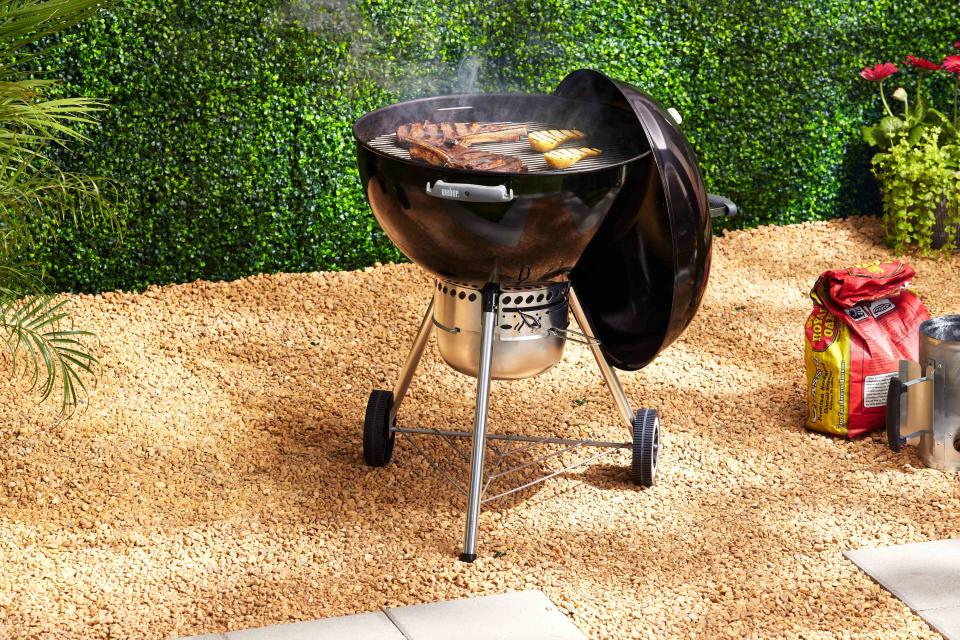
Food & Wine / Russell Kilgore
Grilling is an extension of the original form of roasting: putting food near or above a fire and letting it cook from the radiant heat. Grills just took the method from the fireplace or fire pit and put it into a contained form. Charcoal grilling gained popularity for giving food a smoky flavor without building a fire and waiting for it to burn down to coals before cooking. Put the two together, and you get the ubiquitous charcoal grill.
We tested 17 popular models to determine which stand out from the crowd. Since there’s no one style of charcoal grill, we split the grills into categories: cart and barrel style, tabletop, and kettle. We put each type through the same series of tests to assess how they perform. We found some good, some bad, one almost comically dangerous, and several winners to round out the best charcoal grills to buy right now.
Best Overall: Weber Original Kettle Premium 22-Inch Charcoal Grill

Pros
The grill's heat is consistent across all temperatures, assembly is easy, and grillers of all skill levels can use it.
Cons
A place to hold the hot lid after opening the grill would be an excellent addition.
The Weber Original is still standing after 70 years on the market, and having tested it, we can see why. One person can assemble this grill in 15 to 20 minutes with minimal frustration, and it’s easy to move around, provided you secure the lid with your hand when doing so. The big drawback to the lid is that it fits loosely and jostles when rolling the grill, and it’s big and bulky, with no hinges or support mechanism when removing it, which means you have to find a place to safely put it down after opening the grill. It’s a no-frills grill with adjustable dampers at the top and bottom to regulate convection and temperature and no means to move the grate or charcoal.
It left an excellent sear during our high-heat test with no distinctive grill marks on the food. The dampers make the Weber a strong performer when smoking, as the grill maintained low temperatures with little fooling around. Hinges at the edge of the grate allow you to easily add more charcoal, although that task is less challenging when adding unlit charcoal to the fire than dumping a chimney of hot coals onto the charcoal grate.
Price at time of publish: $219
Primary Cooking Area: 363 square inches
Dimensions: 27 x 23 x 40 inches
Best Cart Style: Char-Griller Classic Charcoal Grill

Pros
The Char-Griller Classic has excellent heat distribution and fuel efficiency.
Cons
The grate arrangement makes adding more charcoal for direct grilling difficult, and a smaller damper might allow more forced airflow through the grill.
The Classic is easy for one person to assemble, taking less than 30 minutes to complete. The charcoal pan is easy to adjust, utilizing a crank that positions the coals anywhere between 3.5 and 8 inches from the bottom of the enamel-coated cast iron grates to regulate the direct heat effects on your food. The front vent and chimney stack allows easy airflow adjustment to control the temperature. Our first round of tests showed it came up to a searing temperature in a reasonable amount of time and left good grill marks with few flareups.
Our second round of tests involved slow cooking, and the Classic demonstrated good temperature retention and fuel efficiency over six and a half hours of cook time. It also scored well in the ease-of-cleaning department, requiring a quick brushing of the grates and a few taps on the bottom of the ash pan to empty it. It’s a heavy grill at 88 pounds, but the sturdy construction and casters (two of which lock) at each corner make it easy to move and stabilize. Plus, it's large enough to fit multiple pork butts, briskets, or whole chickens.
All in all it's relatively easy to use, and the price-to-value ratio is on point. Our editors felt it's intuitive to use for both beginners and experienced grillers, and most importantly, it maintains heat very well.
Price at time of publish: $349
Primary Cooking Area: 550 square inches
Dimensions: 27 x 57 x 52 inches
Best Kettle Style: SNS Grills Slow 'N Sear Original 22-Inch Kettle Grill

Pros
It’s lightweight, easy to move, and easy to use, even for a beginner.
Cons
It’s challenging for one person to set up, the ash collector is difficult to remove, and the hook for holding the grate is made of plastic, so it’s not practical when the grate is hot.
This SnS grill is lightweight, with a porcelain-enamel-coated aluminum construction and a stainless steel grill, aiding the easy movement using the grill’s two large wheels. Both the charcoal tray and the grill are in fixed positions, so heat regulation depends entirely on coal depth and airflow. In our searing test, the grill came up to temperature quickly and gave good caramelization and browning but no defined grill marks, with no sticking issues. Our indirect heat testing showed consistent heat, with only a 15-degree variation during four and a half hours of cooking.
Cleanup was easy with clear directions from SnS, with one exception. We had to fiddle with the ash collection tray to remove it for emptying. As an all-purpose backyard grill, it performs well. This kettle grill brought some grumbling during assembly. It’s not particularly difficult despite a large number of pieces, and the instructions are easy-to-follow, but the job would be easier with an extra set of hands.
Price at time of publish: $335
Primary Cooking Area: 380 square inches
Dimensions: 42 x 42 inches
Best Splurge: Weber Performer Deluxe Charcoal Grill

Pros
The ignition system eliminates the need for a chimney starter, and the grill cooks evenly with good fuel efficiency.
Cons
The dome thermometer skews from our digital tests, and it would be nice if the heat could be more direct without loading in more charcoal to bring the fire closer to the grate.
Weber levels up its classic kettle grill design. At first glance, there are new, additional niceties like a work table, timer, and charcoal storage. Inside, a butane-fueled charcoal ignition system and charcoal-holding blocks eliminate the need for a chimney starter. The center of the grill is hinged, as are the edges, allowing easier access to the blocks when adding more charcoal or chips. All of these additions up the task of assembly, and a second person would make the job more pleasant. It’s easy to move thanks to the locking casters, and there’s a system to hold the lid when removing it.
The Performer did well in the slow-cooking test, with efficient fuel consumption and only a 20-degree variation in temperature over six and a half hours of cooking. Cleanup was simple: empty the ash collector, brush the grates and ignitor, and do a quick wipe down and rinse. Like other kettle grills, there’s no movement of the grate or the charcoal, so high-heat cooking depends on the airflow and the charcoal load. Our high-heat test showed no sticking on the stainless steel grate and gave decent grill marks, with minimal flare-ups but little char. It’s a splurge for a charcoal grill, but it’s pretty user-friendly for all skill levels.
Price at time of publish: $549
Primary Cooking Area: 363 square inches
Dimensions: 30 x 48 x 44 inches
Best Large: Dyna-Glo X-Large Heavy-Duty Charcoal Grill

Pros
It heats quickly and evenly, and it’s easy to clean after cooking.
Cons
We took points off for assembly, and adding charcoal with food on the grill is a chore.
We weren’t fans of this grill while assembling it, as the instructions weren’t clear enough. We recommend having it delivered assembled if you can. We won’t call it easy to move, as it weighs almost 100 pounds. But, it wasn’t difficult, either, and the lid was surprisingly lighter than one would expect for such a large, heavy grill. The grill also heats quickly and evenly for its size, which redeems its difficult setup. It was ready for food in 15 minutes when adding lit coals from a chimney and longer, as is expected when starting with a smaller amount for low-temp cooking.
The bottom dampers took some tweaking for our low-temp tests, but the grill held its temperature reasonably well once we dialed it in. The movable charcoal tray made regulating the heat in our searing tests easier, with good sear and grill marks. Loading charcoal is a simple task when first starting the grill, but additions during longer periods of cooking require moving food and lifting grates, with the temperature dropping along the way. The lightweight ash collection tray facilitates easy cleanup, while the rest of the grill takes no more than a brush and wipe down.
Price at time of publish: $280
Primary Cooking Area: 576 square inches
Dimensions: 28 x 61 x 51 inches
Most Versatile: PK Grills Original PK300 Grill and Smoker

Pros
The PK performs well as a grill or smoker and is easy to assemble and add charcoal while cooking.
Cons
The damper system has a learning curve, and cleanup requires flipping the entire grill.
The versatility of this PK grill makes it a more complex model. Four dampers provide excellent airflow but may prove difficult for a beginning griller to learn to manipulate. As our searing test showed, not fully respecting the power of the airflow can result in flares, over-charring, and dried food. When those dampers work in conjunction with the heat conductivity of the cast aluminum body, the grill heats quickly, reaching a searing temperature in less than 10 minutes when loaded with coals from a chimney. The stainless steel grate has a hinged, removable section that facilitates quickly adding more charcoal during long cooks, and the lid, while heavy, is well-hinged and easy to open and close.
PK refers to the Original as portable; the hard rubber wheels aid in moving the unit, and the legs are adjustable for leveling the grill. Cleaning requires dumping the grill, as there’s no removable ash collection, but the lid comes off easily, which lightens the grill and makes the job far less clumsy. As the ash collects in the bottom of the grill, metal pieces that fit over the bottom dampers prevent ash from clogging them and hot coals from dropping out the bottom.
Price at time of publish: $525
Primary Cooking Area: 316 square inches
Dimensions: 16 x 43 x 37 inches
Best Tabletop: PK Grills PKGo Camp & Tailgate Grilling System

Pros
It has excellent heat retention, and the side-mounted dampers provide excellent heat control.
Cons
It’s heavy, and there’s no ash collection system.
This cast aluminum grill requires little in the assembly department other than placing the components in their proper place, and it heats quickly. How quickly? Our tests showed it approaching 650°F after 10 minutes, which results in excellent searing and grill marks. The enamel-coated cast iron grates minimize sticking and conduct heat very well, and the side-mounted dampers provide excellent heat control.
For open cooking, the included Flipkit turns the two-piece top and bottom into two hibachi grills that double your cooking area, should you wish. Cleanup is easy, but like the PK300, it does require you to flip the grill to empty the spent ash. Aside from that, give the grates a scrape, wipe the body down, and call the job done. The two-grate design makes adding charcoal easier, as you only have to lift half the grate area to make that happen. As a portable grill, it’s a bit heavy at 40 pounds, but with the ability to slow cook, sear, or open cook, it’s got versatility that outweighs the heft.
Price at time of publish: $338
Primary Cooking Area: 204 square inches
Dimensions: 15 x 21 x 13 inches
Our Favorites
In terms of longevity and consistent results, we have to give proper respect to the Weber Original Kettle Premium 22-Inch Charcoal Grill. The somewhat annoying issue of where to put the lid aside, its no-frills design delivers consistent heat and easy heat regulation at a price that justifies the quality. If you're looking for a cart or barrel-style charcoal grill, the Char-Griller Classic Cart Style Charcoal Grill performed the best in this category.
The Tests
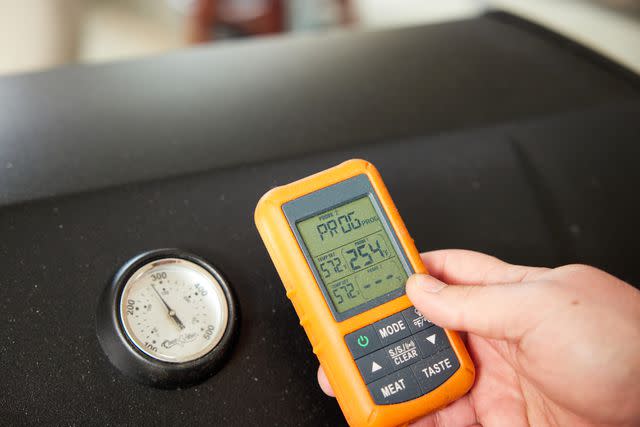
Food & Wine / Russell Kilgore
We put these grills through a series of tasks we'd tackle first after purchasing one. The first step was assembling the grills, noting how long each took, the difficulty level, and how clear the instructions were. The next test was to burn in the grill by loading it with burning charcoal from a chimney in a level layer, opening all the dampers, and checking the temperature after 15 minutes with a wired digital thermometer and comparing it to the temperature of the grill’s built-in thermometer (when applicable). For grills with adjustable charcoal grates, we positioned the grate 5 inches below the cooking grate.
With the grill in a heated state, we oiled it, added a two-pound, bone-in ribeye (about 1.5 inches thick), and let it cook for six minutes with the grill on full-bore. We then flipped the steak, noting any sticking issues, and observed the steak’s grill marks and caramelization, or lack thereof. We cooked the steak for another six minutes, recorded its internal temperature, rested it for five minutes, and recorded the final temperature after the rest. We then cut the steak open and observed its level of doneness and overall appearance in color, grill marks, and caramelization. Closing out the first phase, we then cleaned the grills and noted the ease of cleaning and any special considerations from the manufacturer for cleaning.
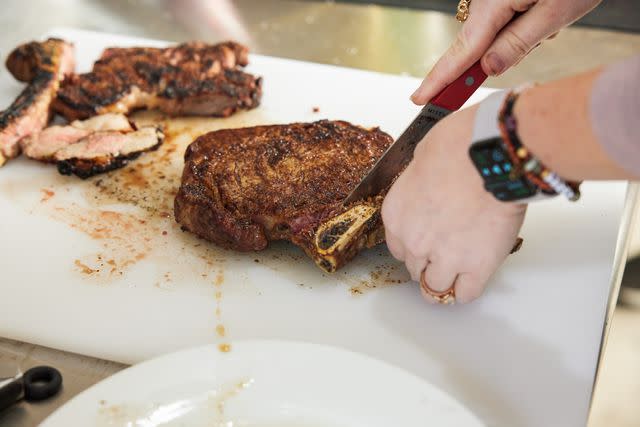
Food & Wine / Russell Kilgore
The highest-scoring grills moved to round two, where we rated them on their slow-cooking capabilities by cooking a slab of ribs. We noted the ambient temperature and weather conditions, the time it took for lit coals to heat the grill to proper smoking temperature, the starting temperature of the ribs, temperature milestones during the process, and how long it took them to reach 185°F internal temperature. During this process, we also recorded the amount of charcoal or smoking chip additions and the elapsed time for adding them. We averaged their scores and used these to arrive at our seven winning grills.
Factors to Consider
Size
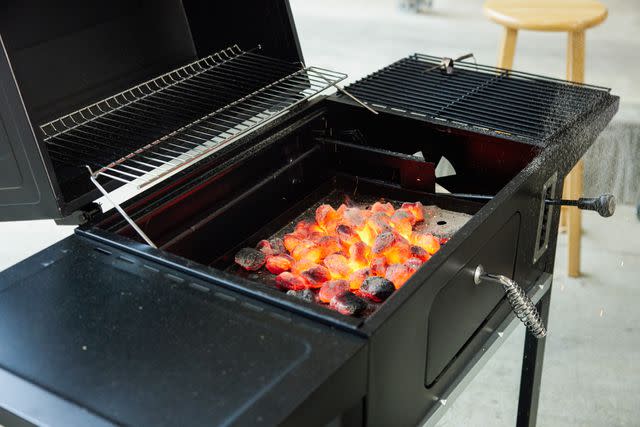
Food & Wine / Russell Kilgore
How you intend to grill should be a guiding factor in selecting the size for you. If you plan on bringing your grill along on camping trips or picnics, you’ll want something easy to move and pack. If you frequently cook for large groups, you’ll want a cart or barrel-style grill, such as the Dyna-Glo X-Large or the Char-Griller Classic Cart Style Charcoal Grill. Remember that the larger the grill, the more charcoal you’ll burn through in cooking.
In smaller form factors, a 22-inch grill like the SnS or Weber Performer should be sufficient cooking space for two to four people. That said, kettle grills offer plenty of usable cooking space for smoking, as most can hold a large brisket or one or two pork shoulders.
Materials
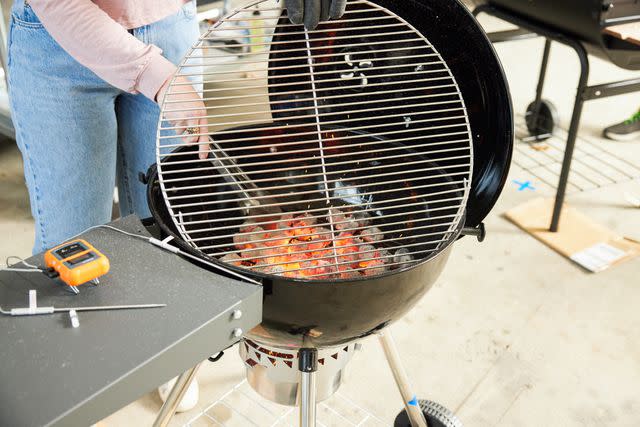
Food & Wine / Russell Kilgore
Lighter-weight grills can perform well, provided they have an enamel coating or something similar. On the other end of the spectrum, the cast aluminum of the PK grills has excellent heat distribution and retention, but the trade-off is a significantly heavier grill. Cast iron or cast aluminum grates will give you better grill marks if those are a significant consideration, as both are more conductive than stainless steel. That’s not to say you won’t get caramelization with stainless steel, but the distinctive patterns won’t be as prominent.
Coal and Ash Management
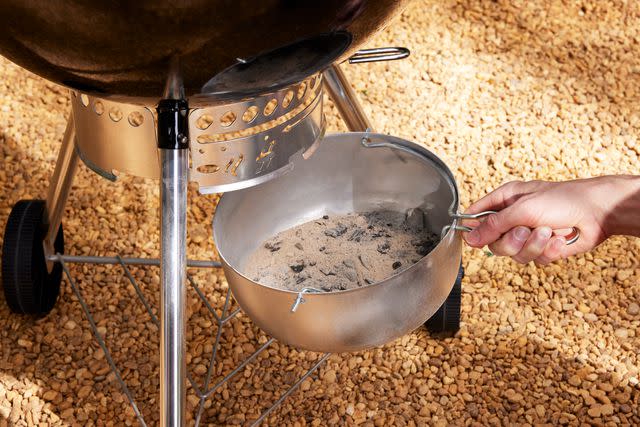
Food & Wine / Russell Kilgore
When using these grills, especially when smoking for long periods, coal and ash management is necessary. You may need to add more charcoal during your cook. Will you have to remove all your food to add charcoal? Are the heavy cast iron grates hinged for easy movement? The grills that performed best in our tests have designs that allow you to do this with minimal risk of getting a burn.
Grates typically dictate how easily you can add more coal. Grates can be fixed, as you'll find with kettle grills, or adjustable, which is typical for barrel-style grills. An adjustable grate has an advantage when it comes to controlling the heat. You can raise the grate for a more intense sear or lower the grate to smoke chicken, for example.
Finally, as charcoal generates a lot of ash, an ash-management system is essential. Some are notably easy or difficult to remove for cleaning, and we've mentioned these above.
Venting
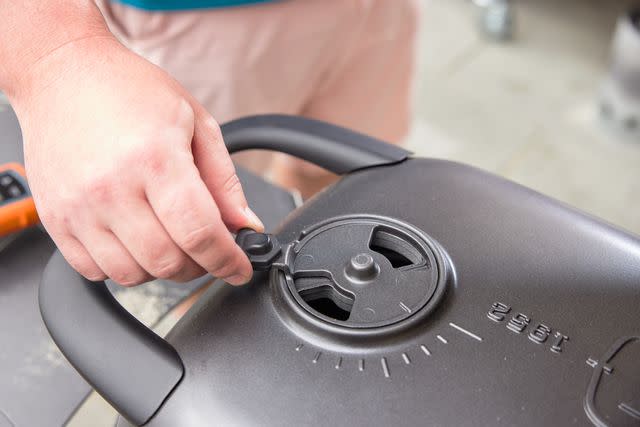
Food & Wine / Russell Kilgore
You need airflow to keep your fire going and to regulate the temperature. If you’re cooking in an open grill, hibachi-style, the airflow isn’t as strong of a consideration. But for closed-lid grilling and smoking, the ideal situation is to create convection. Air enters the bottom of the grill, feeds the fire, then the heated air travels across your food and out the top. Without an easy-to-manage venting system, your temperature will waver or, worse, never get hot enough to cook on.
Frequently Asked Questions
How do you start a charcoal grill?
The cleanest, most reliable method is to use a chimney starter. Using a commercial fire starter block, balled-up paper, or an electric starter, place the lighting method in the bottom of the chimney, add charcoal, and light the starter material. Allow the charcoal to burn until it stops flaming, and add it to your grill. Lighter fluid is an option, but allow the fluid to soak into the charcoal before lighting and allow the fluid to burn off completely before attempting to cook food over the coals.
How do you clean a charcoal grill?
There are two crucial, non-negotiable parts to cleaning a charcoal grill. First, you must clean out the old ash if you want your grill to last. Ash is a great moisture collector and can do so from ambient humidity or just being near rain, even if you keep your grill covered. Wet ash feeds rust, and the rust will eat through your grill in short order. The second is to keep your grate clean. Choose a grill brush to your liking, metal, nylon, or natural bristles, and scrape down your grill after cooking. Accumulated grease and soot remove easily with some mild soap and water.
How do you keep a charcoal grill hot?
Let’s take weather considerations off the table for this discussion. Most charcoal grills have a damper system that draws air through them when the lid is closed, creating convection. Closing the dampers cuts the airflow and lowers the temperature, while incrementally opening them increases the flow, raising the temperature. For a hot fire, you need two things: open, or mostly open, dampers and a closed lid. Opening the lid releases heat and adds air directly to the fire, nullifying the convection. In the barbecuer vernacular, “looking ain’t cooking.” A last consideration is ensuring you have enough charcoal to last through your cook if you’re burning it hot, so you don’t have to lower the grill’s temperature by opening the grill to add more.
Can you use wood pellets in a charcoal grill?
You can, but ensure they’re barbecue pellets, not heating pellets. Most sources like mixing the pellets with charcoal to add a different, smoky flavor profile, but you can use them on their own, too. In a charcoal grill environment, the pellets will burn hotter and faster than in a pellet grill, so adjust your amount of pellets and your dampers accordingly.
Other Charcoal Grills We Tested
Strong Contenders
Char-Broil Performance 580 Charcoal Grill ($149 at Target)
The 580 suffered in two areas. The first was assembly, clocking one of the longer assembly times of the models we tested. The problems arose from the clarity of the instructions, leaving us to question the process at many steps. The second was airflow, where the holes in the charcoal tray didn’t provide sufficient air entering the bottom to reach a reasonable temperature for searing.
Expert Grill 22 Superior Kettle Charcoal Grill ($97 at Walmart)
The Expert is a perfectly adequate grill for the price. It’s just not outstanding. Heat management could improve by shortening the distance between the charcoal and the grates to aid in a better sear.
Char-Griller Deluxe Griller Charcoal Grill ($179 at Amazon)
The Char-Griller is a good grill for the price, but assembly without an extra set of hands is challenging. There were frequent flare-ups when the charcoal sat at the prescribed distance from the grates, and lowering the coals away from the grate might have alleviated that issue.
Oklahoma Joe’s Judge Charcoal Grill ($679 at Amazon)
The most significant drawbacks were the grill’s overall weight and the lid's weight, the latter of which is heavy enough to lift the front of the grill off the ground should one slip and allow it to fall fully open. It burns hot, burning rather than charring the steak during our tests. Lowering the coals would probably yield better results.
What Didn't Make the List
The Royal Gourmet 24-Inch Charcoal Grill ($110 at Amazon) presented multiple problems, starting with a complicated assembly process. Based on the procedures outlined in our testing methodology, the grill also raised significant safety concerns. The heat ran out of control, bubbling the paint and igniting the steak on the grill. These concerns for safety, in addition to somewhat flimsy construction, removed it from the running.
The Cuisinart 18-Inch Kettle Charcoal Grill ($109 at Amazon) is in a similar category for construction, with a grill grate that needs better support and a third of the charcoal falling through the charcoal grates because of the grating spacing. While not presenting safety concerns, it scored poorly for heat management. During testing we noted multiple flare-ups, charring, and uneven cooking, which, combined with the construction, prevented it from progressing to the next round.
Our Expertise
Greg Baker is an award-winning chef, restaurateur, and food writer with four decades of experience in the food industry. His written work appears in Food & Wine, Food Republic, and other publications.
For more Food & Wine news, make sure to sign up for our newsletter!
Read the original article on Food & Wine.

